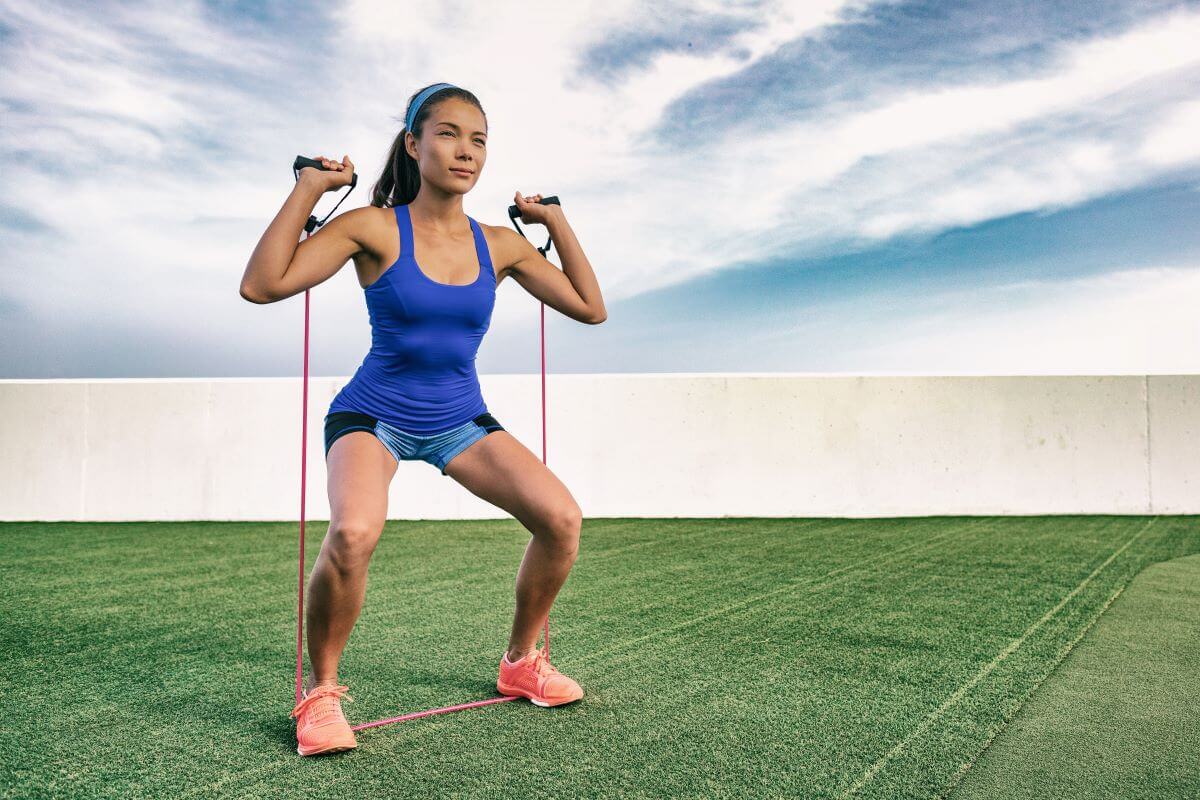The resistance band squat is an excellent exercise to perform when working out at home.
The band provides extra resistance for you to progress with the lower body exercise.
Additionally, the squat is a foundational movement pattern that should be incorporated into your workout routines assuming you are healthy enough to do so.
So, if you’re interested in taking your at-home workouts to the next level, consider investing in a pair of solid resistance bands and begin adding some of these exercise variations into your full body workouts or leg days.
1. Traditional Banded Squat
This variation will likely be the most comfortable for your average person. If you have been performing regular bodyweight squats for a while and have achieved better mobility and depth in your squat, you may want to progress to a banded squat.
The banded squat will work the muscles of the lower body. This includes the hamstrings, quads, glutes, and calves.
For someone looking to add the banded squat to their workout routine, they can do so by adding it to their full body workout. You may also add it in as a main movement for an at-home lower body workout.
A good starting point is 2-3 sets of 6-12 repetitions. If you are a beginner, stick to the lower end of the recommendations. If you’ve been working out for a few weeks, you may be able to begin with the higher end of the recommendations.
How to perform the resistance band squat:
- Align the band on the floor with the midpoint of the band aligned with the midpoint of your torso.
- Step onto the band with your feet about shoulder width apart. Your feet can point out up to 30* if that is most comfortable to you.
- Grasp the band handles or loops and bring them to about shoulder height.
- Tighten your core.
- Begin to squat by driving your hips back and bending at the knees. Pretending you are taking a seat in a chair can help you accomplish the movement pattern. Continue the movement until you reach slightly below parallel or to a depth your mobility allows.
- Reverse the movement by driving into your heels and straightening your legs until you return to an upright stance.
- Repeat for the desired number of repetitions.
2. Wide Stance Banded Squat
Taking a wider stance during a squat will put more emphasis on your glutes. This can be helpful if you have a goal of building strength in your glutes for aesthetic or strength purposes. The wider stance will also increase the resistance the band provides on the movement. Keep this in mind when selecting the band you will use for the exercise.
Wide Stance banded squats can be performed as a main movement or as an accessory exercise depending on your goals.
How to perform the wide stance banded squat:
- Align the band on the floor with the midpoint of the band aligned with the midpoint of your torso.
- Step onto the band with your feet outside shoulder width apart. Your feet can point out up to 30* if that is most comfortable to you.
- Grasp the band handles or loops and bring them to about shoulder height.
- Tighten your core.
- Begin to squat by driving your hips back and bending at the knees. Pretending you are taking a seat in a chair can help you accomplish the movement pattern. Continue the movement until you reach slightly below parallel or to a depth your mobility allows.
- Reverse the movement by driving into your heels and straightening your legs until you return to an upright stance.
- Repeat for the desired number of repetitions.
3. Narrow Stance Banded Squat
Narrow stance banded squats will put more emphasis on the quads. Since the band is less stretched due to your foot placement on the band, this exercise may seem easier from a resistance standpoint. If you find this to be the case, you can select a thicker resistance band to provide more of a challenge.
That said, the narrow stance may prove to be more challenging for some. Especially if you tend to lack the mobility to reach parallel with a mor narrow stance.
If your goal is to build strength in your quads, this might be a good variation to either incorporate as the main squat movement of your workout routines or as an accessory exercise.
How to perform the narrow stance banded squat:
- Align the band on the floor with the midpoint of the band aligned with the midpoint of your torso.
- Step onto the band with your feet inside shoulder width apart. Your feet can point out up to 30* if that is most comfortable to you.
- Grasp the band handles or loops and bring them to about shoulder height.
- Tighten your core.
- Begin to squat by driving your hips back and bending at the knees. Pretending you are taking a seat in a chair can help you accomplish the movement pattern. Continue the movement until you reach slightly below parallel or to a depth your mobility allows.
- Reverse the movement by driving into your heels and straightening your legs until you return to an upright stance.
- Repeat for the desired number of repetitions.
Conclusion
In this article, we discussed 3 different squat variations you can perform with a resistance band. With the versatility resistance bands can provide, these banded squats are perfect for someone looking to workout at home, while traveling, or while enjoying the great outdoors.
As mentioned, you could incorporate any of these resistance band squats into your workouts, or pair them with banded deadlifts and perform all 3 variations for an excellent banded leg workout. To do this, simply perform 2-5 sets of 8-15 reps of each squat variation.
